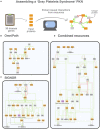Assembling Disease Networks From Causal Interaction Resources
- PMID: 34178043
- PMCID: PMC8226215
- DOI: 10.3389/fgene.2021.694468
Assembling Disease Networks From Causal Interaction Resources
Abstract
The development of high-throughput high-content technologies and the increased ease in their application in clinical settings has raised the expectation of an important impact of these technologies on diagnosis and personalized therapy. Patient genomic and expression profiles yield lists of genes that are mutated or whose expression is modulated in specific disease conditions. The challenge remains of extracting from these lists functional information that may help to shed light on the mechanisms that are perturbed in the disease, thus setting a rational framework that may help clinical decisions. Network approaches are playing an increasing role in the organization and interpretation of patients' data. Biological networks are generated by connecting genes or gene products according to experimental evidence that demonstrates their interactions. Till recently most approaches have relied on networks based on physical interactions between proteins. Such networks miss an important piece of information as they lack details on the functional consequences of the interactions. Over the past few years, a number of resources have started collecting causal information of the type protein A activates/inactivates protein B, in a structured format. This information may be represented as signed directed graphs where physiological and pathological signaling can be conveniently inspected. In this review we will (i) present and compare these resources and discuss the different scope in comparison with pathway resources; (ii) compare resources that explicitly capture causality in terms of data content and proteome coverage (iii) review how causal-graphs can be used to extract disease-specific Boolean networks.
Keywords: causal interactions; causality resources; logic modeling; network medicine; prior knowledge network.
Copyright © 2021 Cesareni, Sacco and Perfetto.
Conflict of interest statement
The authors declare that the research was conducted in the absence of any commercial or financial relationships that could be construed as a potential conflict of interest.
Figures





Similar articles
-
Integrating Patient-Specific Information into Logic Models of Complex Diseases: Application to Acute Myeloid Leukemia.J Pers Med. 2021 Feb 10;11(2):117. doi: 10.3390/jpm11020117. J Pers Med. 2021. PMID: 33578936 Free PMC article.
-
The status of causality in biological databases: data resources and data retrieval possibilities to support logical modeling.Brief Bioinform. 2021 Jul 20;22(4):bbaa390. doi: 10.1093/bib/bbaa390. Brief Bioinform. 2021. PMID: 33378765 Free PMC article.
-
Cognitive IT-systems for big data analysis in medicine.Int J Risk Saf Med. 2015;27 Suppl 1:S108-9. doi: 10.3233/JRS-150711. Int J Risk Saf Med. 2015. PMID: 26639685
-
The shortest path is not the one you know: application of biological network resources in precision oncology research.Mutagenesis. 2015 Mar;30(2):191-204. doi: 10.1093/mutage/geu078. Mutagenesis. 2015. PMID: 25688112 Review.
-
Integrating molecular networks with genetic variant interpretation for precision medicine.Wiley Interdiscip Rev Syst Biol Med. 2019 May;11(3):e1443. doi: 10.1002/wsbm.1443. Epub 2018 Dec 12. Wiley Interdiscip Rev Syst Biol Med. 2019. PMID: 30548534 Free PMC article. Review.
Cited by
-
Curation of causal interactions mediated by genes associated with autism accelerates the understanding of gene-phenotype relationships underlying neurodevelopmental disorders.Mol Psychiatry. 2024 Jan;29(1):186-196. doi: 10.1038/s41380-023-02317-3. Epub 2023 Dec 15. Mol Psychiatry. 2024. PMID: 38102483 Free PMC article.
-
A Resource to Infer Molecular Paths Linking Cancer Mutations to Perturbation of Cell Metabolism.Front Mol Biosci. 2022 May 18;9:893256. doi: 10.3389/fmolb.2022.893256. eCollection 2022. Front Mol Biosci. 2022. PMID: 35664677 Free PMC article.
References
-
- Boué S., Talikka M., Westra J. W., Hayes W., Di Fabio A., Park J., et al. . (2015). Causal biological network database: a comprehensive platform of causal biological network models focused on the pulmonary and vascular systems. Database J. Biol. Databases Curation 2015:bav030. 10.1093/database/bav030 - DOI - PMC - PubMed
Publication types
LinkOut - more resources
Full Text Sources
Miscellaneous

